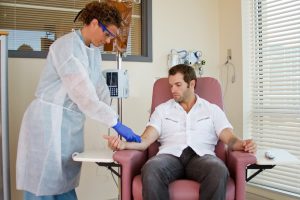Iron Infusion: Treating Severe Anemia with Infusion Therapy

Regional Cancer Care Associates (RCCA) specializes in the treatment of cancer and blood disorders, including anemia. Let’s look at how iron infusion works, and how it can benefit some patients with severe iron-deficiency anemia.
What Is Anemia?
Anemia is the most common blood disorder, and is characterized by a low red blood cell count. Red blood cells carry hemoglobin, an iron-rich protein that helps to carry oxygen to the body’s tissues. When the body does not have enough healthy red blood cells, the tissues do not get enough oxygen.
“Anemia” encompasses many types that can range from mild to severe, be caused by other health conditions, or indicate a more serious health problem. The most common type is iron-deficiency anemia, which is characterized by low levels of the iron the body needs to stay healthy. In iron-deficiency anemia, the body does not have enough iron to function properly, resulting in decreased oxygen delivery throughout the body and often causing symptoms.
Iron-Deficiency Anemia Signs and Symptoms
The symptoms of anemia – along with its diagnosis and treatment – depend on the type of anemia and its severity. People with mild iron-deficiency anemia may not sense a problem while those with moderate to severe anemia can experience many symptoms, including:
- Tiredness or fatigue
- Weakness
- Headaches
- Pale or yellow skin
- Cold hands and feet
- Hair loss
- Irregular or fast heartbeat
- Chest pain
- Shortness of breath
- Dizziness or lightheadedness
- Pounding or whooshing sound in the ears
- Sore or smooth tongue
- Brittle nails
Many of these symptoms can be innocuous and transient, or they could signal anemia or another health problem. Anyone who persistently feels any of the above symptoms should see a doctor, who will determine if testing is needed.
Iron-Deficiency Anemia Risk Factors
Iron-deficiency anemia is most often diagnosed in women and children, although people of all ages and genders can develop it. The iron deficiency that accompanies this type of anemia can result from many different factors – including some that can be managed and some that cannot. Some of these factors include:
- Sex assigned at birth: Women are more likely to develop iron-deficiency anemia than men because menstruation, pregnancy, and childbirth can decrease iron levels.
- Health conditions: Chronic health conditions that interfere with iron absorption can increase a patient’s risk of developing iron-deficiency anemia.
- Diet: People who are not eating properly may have lower-than-recommended levels of necessary vitamins and minerals such as iron, vitamin B12, and folic acid. This can increase anemia risk.
- Pregnancy: Pregnant women face an increased risk of developing anemia if they do not get enough folic acid and iron during their pregnancy.
- Blood loss: Persons with conditions that cause blood loss, such as heavy periods, stomach ulcers, or chronic nose bleeds, also face an increased risk of iron-deficiency anemia.
Research also has shown that infants and children who are premature, not breastfed, or who drink more than 16 to 24 ounces of cow’s milk a day are at higher risk for iron-deficiency anemia because these factors decrease iron absorption.
Persons with any of these risk factors for iron-deficiency anemia can mitigate their risk by making healthy lifestyle changes, including eating a diet rich in iron and increasing their vitamin and mineral intake with supplements.
Diagnosing Iron-Deficiency Anemia
If a patient presents to a primary care provider with symptoms of iron-deficiency anemia, the provider will perform diagnostic tests to determine whether anemia is present and, if so, what is causing it. Some of these diagnostic tests include:
- A physical examination to check for symptoms such as heart murmur, pale skin, and brittle nails
- Blood tests, including tests to measure complete blood count (CBC), iron and vitamin levels, and reticulocytes (red blood cells that are not yet fully developed)
- Other tests to determine the cause, including bone marrow testing, endoscopy, colonoscopy, and urine testing
Once the anemia is diagnosed and the cause is confirmed, the patient’s medical team will have better insight into how best to treat the condition.
Treating Iron-Deficiency Anemia
After iron-deficiency anemia is diagnosed, the provider will recommend a treatment option based on symptoms, severity, and cause. All anemia treatments are designed to increase iron levels until the deficiency is fixed and the body has sufficient iron stores. These treatments include:
Dietary Changes
For mild iron-deficiency anemia, the first suggested treatment is usually dietary changes to increase iron intake. This requires the patient to eat more foods rich in iron, including:
- Meat and poultry
- Fish
- Leafy greens like spinach and kale
- Legumes including lima beans, soybeans, and pinto beans
- Squash and pumpkin seeds
- Eggs
- Tofu
- Dried fruit
- Iron-fortified grains, cereals, pasta, and rice
Often, dietary changes alone will not sufficiently increase iron levels, so another treatment, such as iron supplements, may be added.
Iron Supplements
Iron supplements are suitable for patients with iron-deficiency anemia who do not get enough iron through their diets. Doctors will prescribe special supplements of elemental iron, usually doses of 150 to 200 milligrams daily, that are stronger than over-the-counter multivitamins.
These supplements can help replenish iron levels over time, but they often take 3 to 6 months to work fully. Patients may also experience potentially bothersome side effects, such as constipation or black stools. If side effects happen, a primary care provider can discuss ways to minimize or prevent them.
Iron Infusion Therapy
Patients with more severe iron-deficiency anemia can benefit from iron infusion therapy. This modality entails administering doses of iron to patients intravenously (via a needle placed in a vein in the arm or hand), rather than in a capsule or injection into the skin or muscle. Iron infusion therapy is administered under the supervision of a blood disorder specialist, known as a hematologist.
Iron infusion therapy is especially suitable for patients who cannot tolerate iron supplements, do not absorb iron correctly in the gastrointestinal tract, or have chronic blood loss. The length and frequency of iron infusions will depend on the patient’s specific circumstances.
Blood Transfusions
Red blood cell transfusions are recommended if the severe iron-deficiency anemia is causing distressing symptoms, or during a severe bleeding episode. This method quickly increases the patient’s red blood cell count and corresponding iron levels. Transfusions, however, do not completely correct iron deficiency and are only a temporary solution.
Request a Hematology Appointment Today
The best treatment method for each patient will depend on how low iron levels have fallen – and what caused that decrease. Patients with severe iron deficiency can benefit from an experienced hematologist who has access to the latest advances and treatment options.
RCCA has an experienced team of hematologists who provide treatments for both benign and malignant hematology conditions. These treatments range from infusion therapy for anemia and other blood disorders, to cutting-edge treatments such as immunotherapies for hematologic malignances.
RCCA also has an experienced team of oncologists who provide compassionate, comprehensive care for a range of cancers and other medical conditions.
With 22 locations throughout New Jersey, Connecticut, Maryland, and the Washington, DC area, Regional Cancer Care Associates provides compassionate, comprehensive care close to home. RCCA oncologists and hematologists see more than 26,000 new patients each year and provide care to more than 245,000 established patients, collaborating closely with their patients’ other physicians.
If your anemia is not responding to conventional treatment or you’ve been diagnosed with another serious blood condition, request an appointment today with the hematology department to learn more about treatment options.
